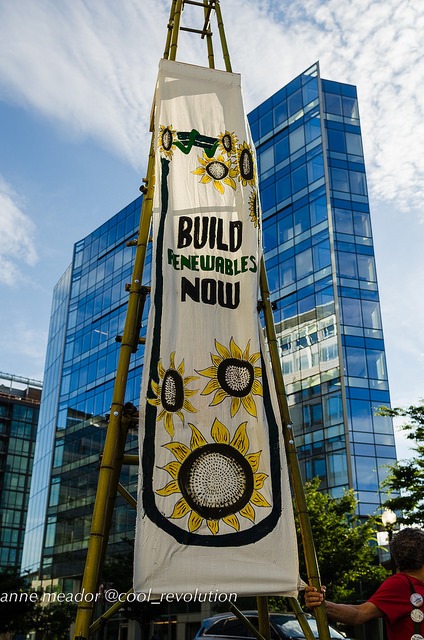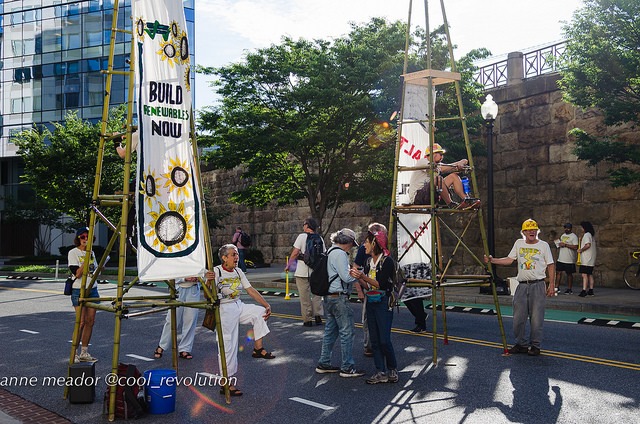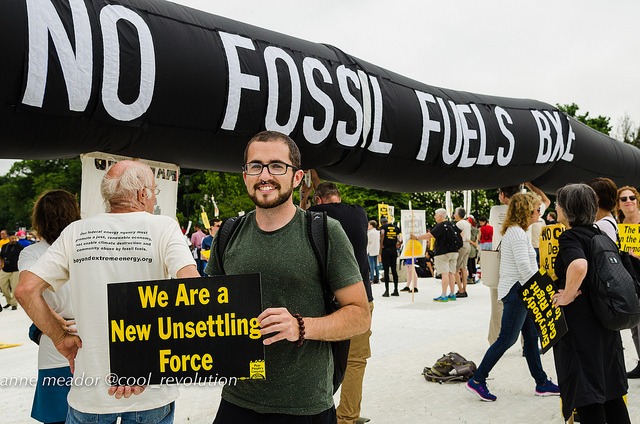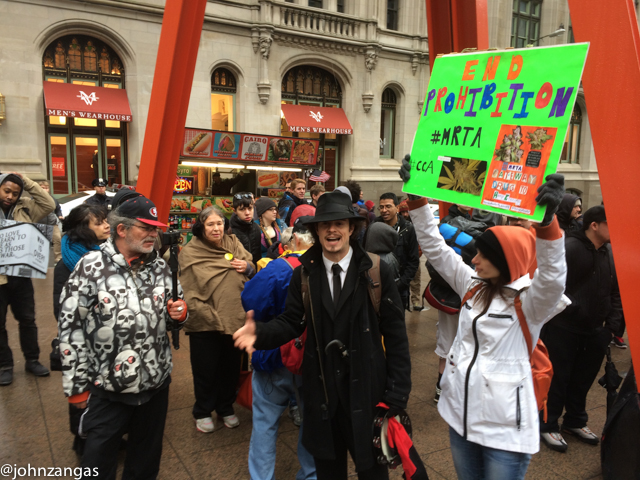
Security at the Federal Energy Regulatory Commission seemed caught unawares Monday morning when anti-pipeline activists blockaded the staff parking garage at the agency headquarters. In the middle of First Street, two people climbed up and perched high on bamboo structures made to resemble hydraulic fracking well derricks. FERC is responsible for approving or denying proposed interstate gas pipelines, most of them supplied by fracking wells.
“FERC greenlights all energy projects, paying no mind to how dirty or unsafe they are to the climate or community,” said derrick-sitter Jessica Sunflower Rechtschaffer of New York City. “We erected these towers in front of FERC to show how these towers are being placed all over the USA, disrupting people, their homes livelihoods and environment.”
The FERC critics from Beyond Extreme Energy (BXE) and other groups, numbering about two dozen, also unfurled a long banner in front of the main entrance, blocking it as well. They say FERC should no longer be “a rubber stamping agency” and instead dedicate itself to facilitating “a just transition off fossil fuels.”
FERC has long been accused of having a “cozy relationship” with industry with commissioners and staff enjoying a revolving door to and from gas industry jobs. Critics also say that it assists gas companies in breaking up projects into smaller ones which will more easily obtain approval, a practice known as segmentation. Meanwhile, communities must grapple with a complex and time-consuming permit process directed toward what seems like a predetermined outcome. FERC has also been accused of “cherry-picking” data to force pipelines through low-income areas and communities of color.
There has been a sustained initiative to draw attention to the broad impact of the agency’s work, as gas companies seize private property and dig up forests, streams and mountaintops with a massive expansion of pipeline networks. For more than four years, BXE has held similar protests at FERC headquarters and disrupted the Commission’s monthly public meetings. Their efforts may be paying off.
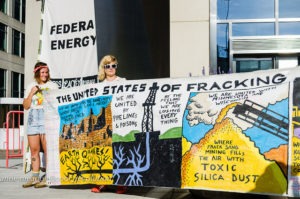 “We’re beginning to see cracks between the FERC commissioners,” derrick-sitter Drew Hudson of North Carolina said, pointing out that earlier this month, Commissioners Cheryl LaFleur and Richard Glick voted to vacate Mountain Valley Pipeline’s permit.
“We’re beginning to see cracks between the FERC commissioners,” derrick-sitter Drew Hudson of North Carolina said, pointing out that earlier this month, Commissioners Cheryl LaFleur and Richard Glick voted to vacate Mountain Valley Pipeline’s permit.
FERC recently embarked on a review of the process governing its permit approvals. There are indications that Democrats LaFleur and Glick are demanding analysis of the climate impacts of pipelines, which would be in accordance with a recent court ruling. But the three Republican commissioners want to shorten the timeline for permit applications and streamline any evaluation.
Swaying only the two Democrats on the Commission may not be enough to achieve BXE’s goal of turning FERC into an agency willing to facilitate a transition to renewable energy. “We need at least three and preferably all five commissioners on board,” Hudson said.
While communities continue to fight FERC, vast numbers of people around the country are affected or potentially affected by the pipelines it approves. An independent safety analysis ordered by Governor Cuomo just released by the New York Department of Public Service finds that FERC was aware that the Spectra Algonquin Pipeline involves unacceptable risks when it approved it in March 2015, according to Kim Fraczek of Sane Energy Project. The Algonquin Pipeline runs only 100 feet from the Indian Point Nuclear Power Plant located 30 miles north of New York City.
“This agency is responsible of saying yes to this pipeline knowing that it was unsafe,” Fraczek, who was protesting at FERC on Monday, said. “It’s putting a population of 25 million at risk. If this pipeline blows up next to Indian Point, it’s game over for the metropolitan New York City area.”


